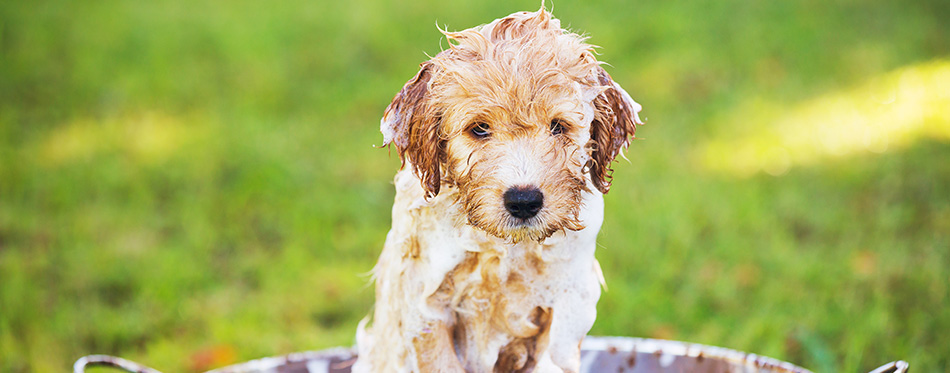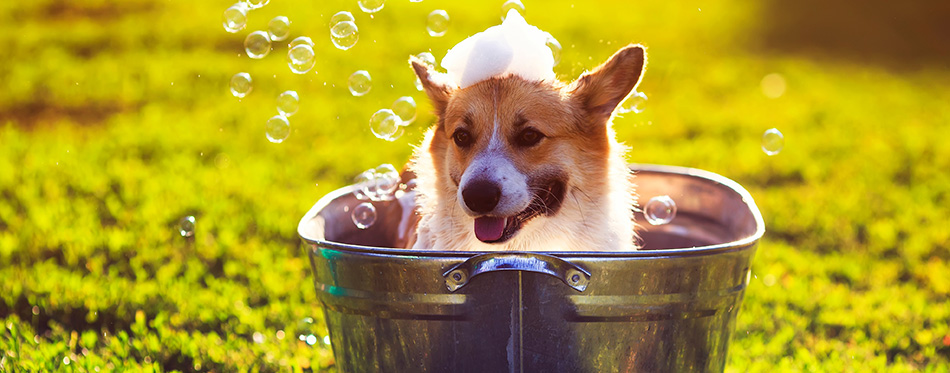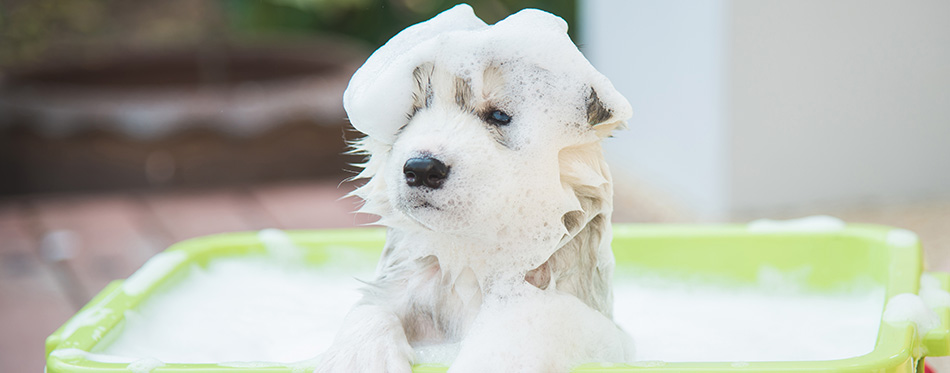Many aspects of looking after a new pup can be a challenge but puppy bathing is something that many new puppy owners get particularly concerned about. The first puppy bath is a big occasion – for the pup and for Mom and Dad! On the one hand, they are told that you should get your puppy used to having a bath. On the other hand, they are told that you should not give your puppy a bath too often or too soon! Trying to do the right thing for your pup can be difficult. Read on to see our non-nonsense guide to bathing your puppy with loads of practical advice and actionable tricks and tips.
When Can I Bathe a Puppy – Best Age to Start
When should you attempt puppys first bath? There is no specific date when you have to attempt puppy bathing for the first time. Your puppy may not need a bath for several weeks. However, if they get very dirty after rolling in mud (or worse) then you will need to get them clean.
In general, you should not attempt to bathe your pup for the first time until they are at least 8 weeks old. If you are not sure of anything relating to the care of your new pup, always contact your vet for advice.
A young puppy’s skin is very delicate and they can get scared by the bathing process so it is best to not bathe them for the first time until they are at least two months old. If they do get very messy before that, you could wipe them down with some baby wipes or a damp cloth.
There is no rush to bathe puppies for the first time as it can cause skin irritation. However, it is a good idea to give them a first bath within the first few months as it will get your puppy used to the experience and they will not find it as stressful when they get older.

Why you Shouldn’t Over-do Puppy Bath Time
Some well-meaning owners can get carried away after the first bath and give their pup too many baths. This can cause problems for your pups and your vet would advise against it.
This is because puppies have natural and friendly bacteria living on their skin. Bathing a puppy that is very young can disturb the bacteria – especially if you use the wrong shampoos. Without the friendly bacteria, your pups’ skin becomes vulnerable to irritation and infection that may lead to you having to take them to the vet for treatment. This is both stressful and expensive.
Also, before the age of 6-12 months, puppies have soft fur. Then, they start to develop water repellent coats. The oils on the coat can be stripped away by bathing your puppy too soon and too often. The oil layer is very important for water-proofing your puppy’s coat. It is this layer that causes the smears on your walls where your dog frequently walks or rubs themselves. It is very important to maintain this layer of oil as it also protects the skin and can be stripped away by shampoos.
How Often Can I Give My Puppy a Bath?
This is a very common question for new puppy parents to ask. Puppies will inevitably get dirty as they explore the world around them. The main point here is that you don’t have to bathe a puppy at all. In the wild, dogs do not bathe. They may have a quick dip in a river or lake but there is certainly no shampoo involved!
However, modern dog owners expect certain standards of hygiene in their pooch so some bathing will be needed. A reasonable puppy bath time schedule is as follows:
- Puppies under three months old: one bath a week
- Puppies aged one month to six months: one bath a month
- Puppies/dogs aged over 12 months: one or two baths a year
However, there will be some circumstances where you will have to bathe a puppy more often than this. This is because there are many benefits that a puppy bath can bring and these are detailed here.
Benefits of a Puppy Bath
Puppy’s first bath, and all the other early baths that you give your pup, bring multiple benefits to your dog and to you.
There can be medical reasons for giving a puppy a bath and this may mean that you need to have puppy’s first bath earlier than you were planning. If your puppy has an infection, a parasite infestation or allergies, your vet may recommend bathing your puppy to help with the symptoms. You may need to use a medicated dog shampoo to bathe your puppy. Always follow your vet’s advice.
There will also be occasions where you will need to give your puppy an emergency bath time because they have rolled in something very unpleasant. Sometimes, you can remove this with a damp cloth or wipes but on other occasions only a thorough soak in warm water will do the trick! You may need to use shampoo to get rid of something that is very sticky or that has a really bad odor. This protects your own clothes and your own home from getting damaged and smelly too!
Having a dog that hates bath time is difficult for owners. There will inevitably be a time when they need a bath so it is worth getting your pup used to it whilst they are young. The same applies to all grooming activities. This is why you should brush your puppy and cut their nails from a young age.
What you Need for Puppy’s First Bath
Before you start to bathe a puppy, it is important that you gather together everything that you need. This will ensure that you are calm and organized when you carry out this important task for the first time. You may also want to follow some basic training tips before you attempt the first puppy bath time so that you can maintain some control of your energetic pup!
Do not be tempted to use human shampoo. Whatever your pup’s coat type, the pH (acidity) of their skin is different to that of humans. By using a product designed for the human body, you will upset the delicate biochemical balance of the puppy’s skin and this could lead to irritation. Human toiletry products are also often highly perfumed and will cause serious irritation if they get into a dog’s eyes. Instead, use a special puppy shampoo that is designed to work in harmony with their body.
You also need a container to bathe them in, a plentiful supply of water, a puppy brush, a towel (or two) and a hair dryer. You may also want to store some treats nearby to keep your puppy distracted. A helper will also probably be required until your pup learns to sit still and co-operate with you.
Check out some of our dog grooming guides, such as dry shampoos for dogs, dog nail clippers, dog wipes, dog dryer, dog clippers, and dog drying towels.
Where to Bathe a Puppy?
Bathe your pup for the first time in a warm room. You can use a special container, your bath tub or even the kitchen sink. If you use the bath tub or a special plastic tub for dog bathing or even if you use a sink, you may want to put a rubber mat on the floor to stop them from slipping when they get out. It also protects the floor surface in your home. Find out more about dog bathtubs here.
The advantage of giving your puppy a bath in the kitchen sink is that it is at your level so you do not have to bend down. Also, it is a small container and therefore less alarming for a young puppy. The disadvantage is that your puppy could potentially leap out and hurt themselves. Also, you have to lift your puppy up into the sink which can be a challenge as they get older and when they are soaking wet!

Can Puppies Shower Instead of Bathing?
If you don’t think that you have anywhere suitable in your home to bathe your puppy, you may consider giving them a shower instead. There is the option of using your own shower in the house – just be careful to only use a warm water setting and not the hot water setting which could scald your puppy. Also, be prepared to get very wet as you will probably end up under the shower with your dog.
You could invest in a portable shower spray that comes with its own five-liter tank. You can use this anywhere to rinse your puppy including outside in your yard. However, young pups should not be showered outside in cold weather as they could get chilled.
You can also get battery operated shower heads that are useful for the rinsing process to get rid of shampoo after you bathe your puppy. It sucks up water from a bucket. Shampoo should not be left in puppy coats because it can cause irritation.
Bathe Your Puppy in 3 Easy Steps
Prepare the Water and Wet the Pup
Prepare a bath of lukewarm water in a tub or sink. Young dogs prefer warm water to an ice-cold bath! Coax or lift your pup into the water and remove collars and harnesses. Persuade your puppy to stand still in the water – you may need to use your helper and some tasty treats to achieve this especially if you are bathing your puppy for the first time. Use your hand as a cup (or a plastic container) to soak your puppy with water. Some dogs love the feeling of this but others are not so keen. It can take some time as there will be a waterproof coating on their fur.
Shampoo and Rinse
Use one hand to spread a slick of shampoo down the center of your pup’s spine. There are range of dog shampoos to choose from but a special puppy shampoo may be the best choice as it will have a mild formulation to suit sensitive puppy skin.
Using your wet hands, work the shampoo into the coat – be firm but gentle. Start with the trunk and then work your way down each leg. Don’t forget their tummy and around their bottom.
As you bathe your puppy, make sure that no shampoo goes onto your puppy’s face and take great care that it does not get into their eyes or ears where it can cause serious irritation.
Rinse and Repeat the Process
Dogs have sensitive skin so it is important to thoroughly rinse off all of the shampoo. You can do this using a shower head but for little puppies, it may be less stressful if you use a plastic cup and trickle the water gently over them. Be very careful not to allow any soapy water to enter the ear canals where it could cause irritation and pain for your puppy.
Then, apply more shampoo to your puppy in the same way and work it in. It should work into a lather a bit more readily this time which makes the job easier. This will also need to be rinsed off thoroughly. However, by this stage, your puppy may be getting fed up so this may be a good time to introduce the treats to distract them! Your helper may also have to get involved to keep the puppy in the tub or sink whilst the rinsing process takes place. It can be hard to catch a pup covered in shampoo when they decide they want to escape!
Are Dog Conditioners Necessary?
There is a divided opinion amongst dog owners when it comes to dog conditioners. Some people love them and feel that they prevent knots and matting in dog’s fur. They may make it easier to brush your puppy and less uncomfortable for them. A puppy with a long coat may benefit the most from a conditioner.
On the other hand, many owners feel that this is an unnecessary step. They think that it is stressful for a puppy to introduce yet another step to the bath time. Others worry that it may cause irritation. If you do decide to use a puppy conditioner, make sure that it is thoroughly rinsed out afterwards. If any irritation does occur, stop using it.

Drying a Puppy After Bath Time
Getting your puppy out of the bath without getting completely soaked yourself can be tricky! The best approach is to lay one towel across your lap. Then use the other towel to scoop up your puppy. You will need to be quick! A wet dog’s instinct is to have a good shake to dry themselves off. Even a small pup can hold a lot of water and can get their owner (and your home) very wet!
Use both towels to give your puppy a good rub. Your pup will see this as a great game and will join in with a few nips and will try and grab the towel for a tug-of-war competition. This is the best bit of bath time for them so you need to allow it to be fun whilst also getting the job done!
If your pup stays in a warm room, it is fine to let them air dry for a few hours. However, if you are in a hurry for your little dog to go back outside, or if the temperature in your home is cold, it would be best to speed things up with a hair dryer. Not all dogs are pleased about this! Some can get distressed by the noise. Start gradually with the dryer on a low setting and held a long way away from your little pooch. If they don’t seem to mind, you can get closer and turn it up. However, only ever use the low temperature setting to prevent your puppy from betting a burn.
It is very important that your dog is completely dry after the bath. If they have a damp coat for prolonged periods, they can develop localized fungal infections or hot spots which can be challenging to resolve.
Final Words on a First Puppy Bath…
Bathing your pup for the first time can be a fun experience for both of you. Whilst it is a good idea to get a young puppy used to having a bath, there is no rush to get it done and you should always wait until they are over 8 weeks of age. Dogs only need to be bathed a few times a year – when they get very messy or if you need to control dog odor. Sometimes, vets recommend bathing dogs for medical reasons. The key to a successful puppy bath is getting the right equipment ready beforehand and keeping calm! Make sure that all the shampoo (and conditioner if you are using it) is thoroughly rinsed out. It is also important that all the layers of your pup’s coat are completely dry. Now, you can go and enjoy your pup’s first bath!

